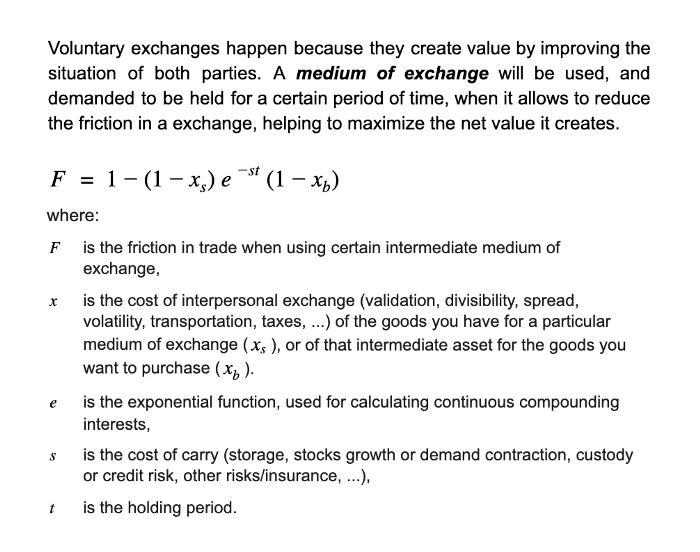The intrinsic value of Bitcoin (II)
| If you find WORDS helpful, Bitcoin donations are unnecessary but appreciated. Our goal is to spread and preserve Bitcoin writings for future generations. Read more. | Make a Donation |
The “intrinsic” value of Bitcoin (II)
By Manuel Palavieja
Posted October 5, 2020
I am quoting the word “intrinsic” because I don’t think it is an appropiate term to refer to value as I explained here. That being said, in this post I’ll stick to the definition of intrinsic value normally used in finance.

Bitcoin is a medium of indirect exchange, whether its intended use is short term (payments) or long term (store of value), but in both cases it is a medium of indirect exchange for different holding periods. Therefore, Bitcoin is a tool for exchange, and all tools derive its value from the costs they save. Let’s find out with an example:
If I am offering 1 kilogram of tulip bulbs in exchange for a hammer, that’s because the hammer is more valuable to me than the tulip bulbs. We can express the the raw value I will get from that exchange using the following simplified¹ formula:
Raw Value = Value(hammer) - Value(tulips)
But doing an exchange through barter is very expensive in time and other resources as it will be hard to find someone that offers a hammer in exchange for 1kg of tulip bulbs. The cost of the exchange will probably be greater than the Raw Value², so it may never take place. In order to optimize the value I get from the exchange, I can use a medium of indirect exchange (let’s call it “X”), and I will choose the one that maximizes the total value for the expected time (“t”) needed to complete the exchange:
Net Value = Value (hammer) - Value (tulips) - Costs (X) * t
How does Bitcoin fit into the above? Easy: Bitcoin is objectively the asset with the intrinsic qualities that render the lowest costs of carry of all available assets, which makes it very convenient for long term exchanges compared to its alternatives (public debt, fiat or gold), those qualities are:
- Lowest dilution costs (gold global stock grows 2% annually)
- No counterparty risk costs (risk of default or inflation)
- Cheap to store and secure (easy to hide, difficult to confiscate)
A more suitable example for Bitcoin would be to exchange my services as a consultant during my young years for a nice home at the beach for my retirement. Nevertheless, there is currently another important cost in Bitcoin which is the cost of its price volatility. However, price is just an exchange ratio, and as such it is extrinsic to Bitcoin. Price volatility is a sign of the market assessing the intrinsic qualities of Bitcoin, testing and vetting if those qualities are for real or not, which is a long process as we all know. After all, very few, if any, get Bitcoin at the drop of a hat.
This post is inspired on Fernando Nieto’s extremely valuable insights, which can be summarized, in a much rigorous way that I did in this post, with the following formula:

¹ For didactical purposes this is a simplification of Fernando Nieto’s formula.
² “Exchange is an economic good” Chapter 1 - Currency Theory, Bondone 2012
